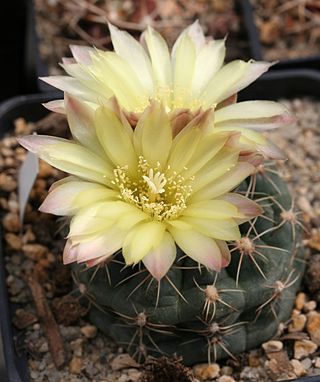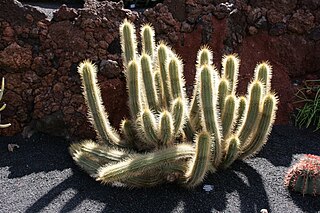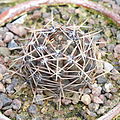
Gymnocalycium eurypleurum is a small "chin cactus" that is highly prized by cactus collectors and is known to be fairly easy to grow, albeit very slow

Gymnocalycium baldianum, the spider-cactus or dwarf chin cactus, is a species of flowering plant in the cactus family Cactaceae, native to the Catamarca Province in Argentina.

Gymnocalycium oenanthemum is a species of flowering plant in the family Cactaceae, endemic to Argentina. A slightly flattened sphere growing to 12 cm (4.7 in), it has 10-13 ribs, each containing a row of tubercles with radial spines. In summer it bears a wine-red or pink daisy-like flower.

Soehrensia thelegona is a species of cactus in the Soehrensia genus.

Harrisia tortuosa is a species of cactus in the Trichocereeae tribe.

Praecereus saxicola is a flowering plant in the family Cactaceae that is found in Bolivia, Argentina and Paraguay

Gymnocalycium monvillei is a species of Gymnocalycium from Argentina.

Gymnocalycium bruchii is a species of Gymnocalycium from Argentina.

Gymnocalycium amerhauseri is a species of Gymnocalycium from Argentina.

Gymnocalycium andreae is a species of Gymnocalycium from Argentina.

Gymnocalycium bayrianum is a species of Gymnocalycium from Argentina.

Gymnocalycium spegazzinii is a species of Gymnocalycium from Argentina and Bolivia named after the botanist C. L. Spegazzini.

Gymnocalycium ochoterenae is a species of Gymnocalycium from Argentina.

Cleistocactus parviflorus is a species of columnar cacti in the genus Cleistocactus.

Acanthocalycium leucanthum is a species of flowering plant in the cactus family Cactaceae from Argentina.

Soehrensia thelegonoides is a species of Soehrensia found in Argentina.

Cephalocereus euphorbioides is a species of Cephalocereus from Mexico.

Gymnocalycium berchtii is a species of Gymnocalycium from Argentina.

Gymnocalycium bodenbenderianum is a species of Gymnocalycium cactus from Argentina.

Gymnocalycium capillense is a species of Gymnocalycium cactus from Argentina.
























